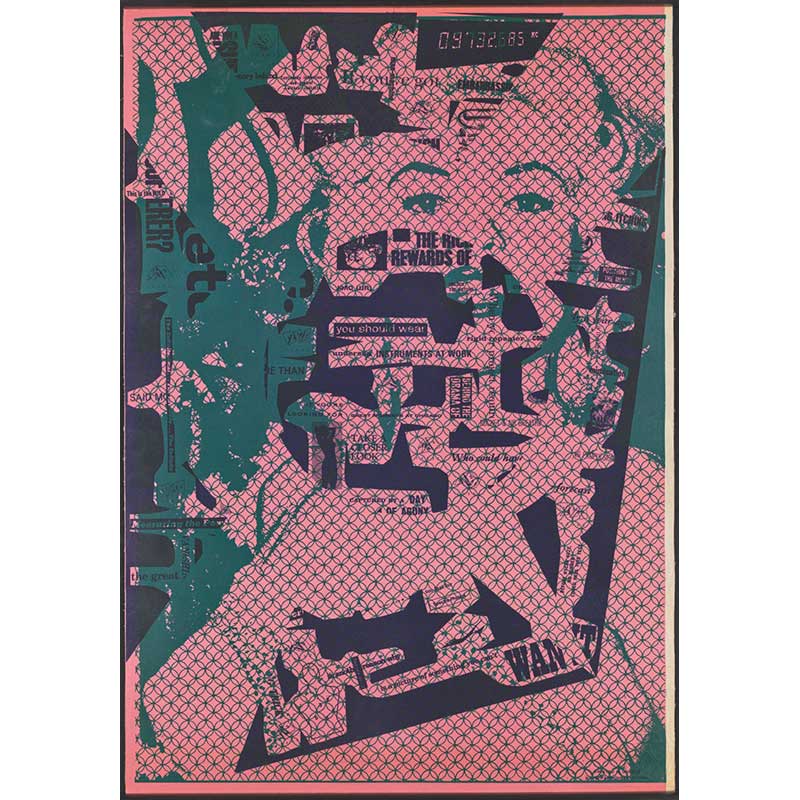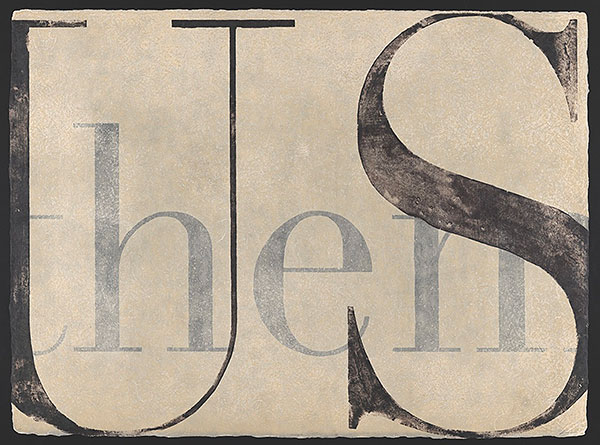
In one print, the light from an unseen window falls across a series of affirmational statements. In another, interlocking, repeated letters in Cyrillic text encircle a tricycle wheel. Across the gallery, the top halves of the letters that spell “DUCHAMP” are positioned below a portrait of the Hip Hop artist Ice Cube. Elsewhere, text in eclectic typeface that resembles advertising slogans, as though extracted from magazine pages, is arranged like spokes in a visual splatter. In another, the word “voice” comes together across three colorful vertical panels, its letters—and, perhaps as a result, its sonic connotations—stacked and jumbled. And bold text, irregularly spaced and sized, is set against a blue mottled background and declares that letters are things in themselves and not merely signifiers.
These artworks and others that make prominent use of text are on display at the Ransom Center in Art in Words: Prints from the 20th Century to Today, an exhibition organized by Curator of Art Tracy Bonfitto with assistance from Research Associate Cristina Meisner.

Artists have explored the visual possibilities of letters and words in many forms, from cubist and Dada experimentations with text to pop and conceptual works. The results have incorporated the visual languages of art, design, poetry, and commercial advertising; offered unexpected juxtapositions; and imagined new associations. These ambiguous, playful, or poignant artworks that treat text as an artistic medium challenge the semiotic limits of the printed word and persuade viewers to question their understandings and associations with text, typeface, and design.
Two recent acquisitions are featured in the exhibition and are on view at the Ransom Center for the first time. The first of these is a set of ten 10-by-8-inch broadsides, published between 1965 and 1967 and referred to as “plakats” by Openings Press. In his Plakat 1, typestract, the reproduction of a work originally created on a typewriter, British concrete poet Dom Sylvester Houédard (1924–1992) arranges and overlaps individual letters until they form not words but a variety of signs and patterns. In Plakat 4, calendar, by Canadian poet Barrie Phillip (bp) Nichol (1944–1988), the letters spelling out each month are repositioned in visual permutations that instead suggest temperature, absence, or sound.

The second recent acquisition, Kristin Calhoun’s (b. 1976) US & them (Imbalances), is a lithograph from 2014 printed on both sides of a sheet of Inomache Nacre paper that has been treated by the artist with beeswax. Here, in a work with ever-increasing relevance, the viewer is encouraged to consider the nature of belonging and the construction of its limits.
Art in Words comprises prints rather than examples from the rich traditions of artists’ books or satirical broadsides—both of which are well represented at the Ransom Center. Instead of being built around works that rely on the form of the book or that present images in illustration of expositional text, the exhibition highlights the use of words and their graphic presence in the advancement of a visual argument. Here, individual words have denotational and connotational trajectories, but are also typographically rendered, cropped, and positioned in ways that create additional layers of meaning.

Many of the prints in the exhibition gesture to larger holdings at the Ransom Center. There are, for example, three Poem Posters by Charles Henri Ford (1908–2002) on display; the Ransom Center holds 12 additional posters, as well as a number of collage works by Ford and significant manuscript material created by and related to the writer, artist, editor, and filmmaker. The three prints by Jasper Johns (b. 1930) and Robert Rauschenberg (1925–2008) with Andrei Voznesensky (1933–2010), published by Universal Limited Art Editions, are a small selection of the many examples of collaborations between visual artists, writers, and fine presses that are part of the Ransom Center’s art collection. These larger holdings can be explored in the Ransom Center’s Reading and Viewing Room.

On display through February 25, Art in Words exposes the tensions and fissures between words and the meanings we carry and expect to associate with them. The exhibition encourages the viewer to think differently about “letters” and seeks to consider them instead—in the words of artist David Kindersley (1915–1995)—as “things.” To do so opens up new possibilities for both reading and viewing.
Dr. Tracy Bonfitto is the Curator of Art at the Ransom Center.
TOP IMAGE: Charles Henri Ford (American, 1908–2002), Jayne as Jayne [Poem Poster], 1964-65. Offset lithograph. Charles Henri Ford Art Collection, 68.116.9.
